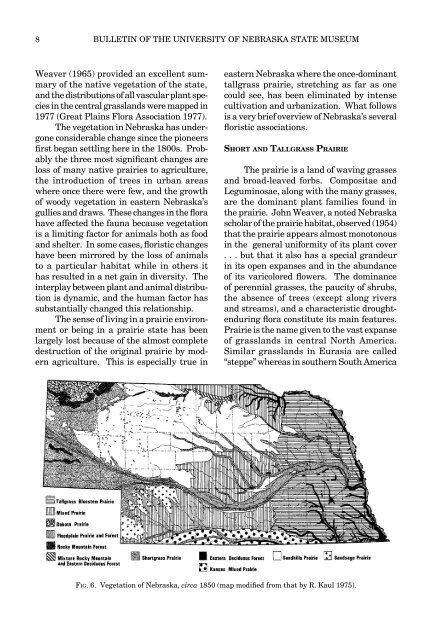Download full text - University of Nebraska State Museum
Download full text - University of Nebraska State Museum
Download full text - University of Nebraska State Museum
You also want an ePaper? Increase the reach of your titles
YUMPU automatically turns print PDFs into web optimized ePapers that Google loves.
8<br />
BULLETIN OF THE UNIVERSITY OF NEBRASKA STATE MUSEUM<br />
Weaver (1965) provided an excellent summary<br />
<strong>of</strong> the native vegetation <strong>of</strong> the state,<br />
and the distributions <strong>of</strong> all vascular plant species<br />
in the central grasslands were mapped in<br />
1977 (Great Plains Flora Association 1977).<br />
The vegetation in <strong>Nebraska</strong> has undergone<br />
considerable change since the pioneers<br />
first began settling here in the 1800s. Probably<br />
the three most significant changes are<br />
loss <strong>of</strong> many native prairies to agriculture,<br />
the introduction <strong>of</strong> trees in urban areas<br />
where once there were few, and the growth<br />
<strong>of</strong> woody vegetation in eastern <strong>Nebraska</strong>’s<br />
gullies and draws. These changes in the flora<br />
have affected the fauna because vegetation<br />
is a limiting factor for animals both as food<br />
and shelter. In some cases, floristic changes<br />
have been mirrored by the loss <strong>of</strong> animals<br />
to a particular habitat while in others it<br />
has resulted in a net gain in diversity. The<br />
interplay between plant and animal distribution<br />
is dynamic, and the human factor has<br />
substantially changed this relationship.<br />
The sense <strong>of</strong> living in a prairie environment<br />
or being in a prairie state has been<br />
largely lost because <strong>of</strong> the almost complete<br />
destruction <strong>of</strong> the original prairie by modern<br />
agriculture. This is especially true in<br />
eastern <strong>Nebraska</strong> where the once-dominant<br />
tallgrass prairie, stretching as far as one<br />
could see, has been eliminated by intense<br />
cultivation and urbanization. What follows<br />
is a very brief overview <strong>of</strong> <strong>Nebraska</strong>’s several<br />
floristic associations.<br />
Sh o r t a n d ta l l g r a s s Pr a i r i e<br />
The prairie is a land <strong>of</strong> waving grasses<br />
and broad-leaved forbs. Compositae and<br />
Leguminosae, along with the many grasses,<br />
are the dominant plant families found in<br />
the prairie. John Weaver, a noted <strong>Nebraska</strong><br />
scholar <strong>of</strong> the prairie habitat, observed (1954)<br />
that the prairie appears almost monotonous<br />
in the general uniformity <strong>of</strong> its plant cover<br />
. . . but that it also has a special grandeur<br />
in its open expanses and in the abundance<br />
<strong>of</strong> its varicolored flowers. The dominance<br />
<strong>of</strong> perennial grasses, the paucity <strong>of</strong> shrubs,<br />
the absence <strong>of</strong> trees (except along rivers<br />
and streams), and a characteristic droughtenduring<br />
flora constitute its main features.<br />
Prairie is the name given to the vast expanse<br />
<strong>of</strong> grasslands in central North America.<br />
Similar grasslands in Eurasia are called<br />
“steppe” whereas in southern South America<br />
Fig. 6. Vegetation <strong>of</strong> <strong>Nebraska</strong>, circa 1850 (map modified from that by R. Kaul 1975).
















